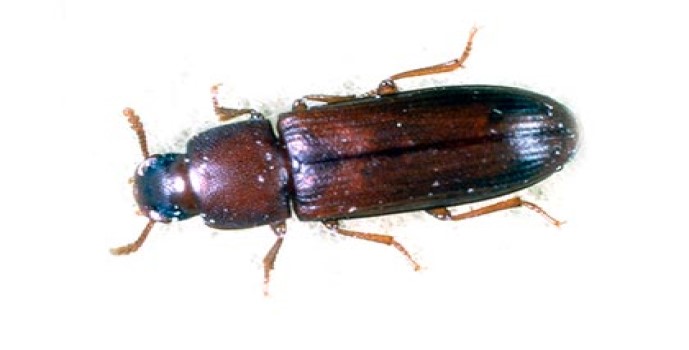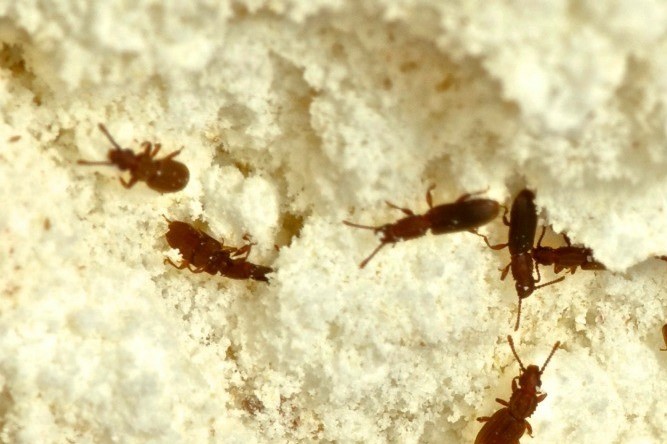Christmas is over and a new year has just begun. For many of us, our kitchens have been bustling with activity over the past 6 weeks as foods and treats of all sorts have been made and consumed. Whether you opted for a pecan pie, sugar cookies, a gingerbread house, chex mix, or a cracker platter, holiday goodies have surely abounded. With generosity being the clarion call of Christmas, most people will find their fridges and pantries still brimming with treats well into the new year, and well past the start of new year’s resolutions. Though most treats will eventually find their way into tummies or trash cans, all the remnant baking supplies are sure to be kept, gradually being pushed farther and farther back on shelves until they are all but forgotten. But just because you’ve forgotten about them, doesn’t mean they’ve been abandoned, for it’s just when you’re not looking that flour beetles can move in and eventually take over your pantry, turning your new year into a new headache.

What do Flour Beetles Look Like?
There are 2 main types of flour beetles in the United States, the red flour beetle and the confused flour beetle; these 2 species are virtually identical in every way (appearance, behavior, habitat, food source, and control methods), so much so that the confused flour beetle gets its name from the fact that it was initially mistaken as the red flour beetle when it was first encountered. Adult flour beetles are around 1/8 to 1/4 inch long, have flat, oval-shaped bodies, are reddish-brown in color, have 2 clubbed antennae, and have wings (though only the red flour beetles are known to fly). Their eggs are tiny, white, cylindrical, and coated with a sticky secretion that will become covered with the food source in which they are deposited; eggs are deposited in groups of 2 or 3, with up to 1,000 eggs being laid by a single female in her life span. When the eggs hatch (in 5 to 12 days), a yellow-white cylindrical grub, less than 1/8 inch long, emerges and grows for the next 27 to 29 days until it pupates. The pupae are similar in appearance to the larvae, but are a lighter, more whitish color, and are only around for 3 to 7 days before the adult beetles emerge. Adults can live for up to 3 years.

Where do Flour Beetles Live?
These pests are found throughout the world, and though there is overlap in their distribution in the United States, generally red flour beetles are found in southern states, and confused flour beetles are found in northern states. They are primarily an indoor pest, living in and around their food sources. You will most commonly find them in stored food items, or in cracks and crevices in pantries, cabinets, and baseboards.
What do Flour Beetles Eat?
Both adult and larval flour beetles eat stored food, primarily milled or prepared items. Common examples include: flour, corn meal, grain products, cereal products, shelled nuts, spices, chocolate/cacao, dried beans/peas/peppers/vegetables/fruits, dry pet food, birdseed, dried milk, dried flowers, animal hides, museum specimens, and even some drugs. Though they cannot consume undamaged grains or unshelled nuts, they can survive off very small amounts of food and are able to subsist off as little as the grain dust that occurs in packages from the grains rubbing against each other.

Are Flour Beetles Dangerous?
Given their ability to rapidly proliferate, it’s fortunate that flour beetles do not pose a direct danger to people or pets. They do not bite or sting, are not toxic, and are not known to carry disease. However, their presence in food products does make the food unfit to consume and can very quickly become both costly and a source of major food waste. Not only is it unpalatable to think of eating these beetles, their eggs, larvae, and pupae, but since they live where they feed, the food products will also be contaminated with their dead bodies, fecal pellets, and secretions. In large populations, this will cause the contaminated food to take on a foul odor, turn grayish, and often encourages the growth of mold. Once infested, the food products should immediately be thrown away.

How do you Prevent Flour Beetles?
Generally speaking, if you have a flour beetle infestation, it initially came home with you from the store. This means that the most vital step in preventing an infestation is a thorough inspection of any susceptible goods (see above for examples of their food sources) before you purchase them or bring them into your home. If you notice any leakage from a susceptible item (i.e. particles falling from a bag of flour) or see any holes, tears, chew marks, or cuts in the cardboard or plastic packaging, do not purchase the item as there is a good chance it has been contaminated.
Once home, store all dried foods, including pet foods, in tightly sealed glass or plastic containers. Additionally, be sure to regularly go through your stored foods and dispose of any that are out of date or haven’t been used in a long time, and be especially cautious when buying in bulk that you will quickly go through the amount you are buying and it won’t simply sit on a shelf becoming a likely home for pests.
Maintaining good sanitation practices will also go a long way in preventing a flour beetle infestation. Regularly sweep/vacuum and wash all areas where food is prepared or stored. If there is a spill, be sure to clean it up immediately. If possible, caulk around the edges and cracks and crevices of your pantry to make clean up easier and less likely for crumbs to be overlooked.
And, as always, at the first sign of an pest problem, call The Bug Dude to get an expert technician to assess and treat the issue before a problem becomes an infestation.
How do you Eliminate Flour Beetles?
Once it’s been determined that flour beetles have invaded your home, it’s important to act quickly before the issue escalates and you find yourself faced with thousands of pests costing you more and more money in wasted foods. At the first sign of trouble, call The Bug Dude at 800-310-BUGS (2847) and set up a treatment of the affected area(s). Then, see if you can locate the source of the pests; thoroughly inspect all food products or natural decorations in the areas where flour beetles have been seen and immediately throw away any that show signs of infestation (beetles, holes in the packaging, discoloration, foul smell, etc.). When throwing away infested items, bag them up and take them directly to an outdoor trash can. If you want to keep infested decorative items, the beetles can be killed by heating the object to 120° F for several hours or freezing for at least 6 days at 0° F. Once all items have been inspected, if the source still has not been found, consult your Bug Dude technician for help in locating other possible harborage areas. When the source of the infestation has been found and removed, perform a thorough cleaning of the entire area where it had been; this may be a cupboard, an entire pantry, or a whole kitchen, depending on how severe the infestation was. Be sure to do a thorough clean: sweep/vacuum, remove and clean under shelf paper, wash and dry shelves, and pay special attention to cracks and crevices. Finally, have The Bug Dude treat the previously infested area(s) to kill any remaining beetles or eggs before they have a chance to rebuild their population and destroy more products.
This year, as you are saying “out with the old and in with the new” for 2022, make sure that you don’t forget to include your kitchen and pantry, and help get the new year off to a prosperous, and pest-free, start.
Further Reading:
“Flour Beetles” – Mike Merchant, Bradleigh S. Vinson, and Wizzie Brown – Extension Entomology – Texas A&M Forest Service
“common name: confused flour beetle & common name: red flour beetle” – Rebecca Baldwin and Thomas R. Fasulo, University of Florida – Featured Creatures – Entomology & Nematology – University of Florida
“Reason No. 138 to Decant Dry Goods (Or, How to Prevent Flour Beetles: A Cautionary Tale)” – Annie Quigley – The Organized Home
“Stored Product Pests: Red And Confused Flour Beetles” – Linda J. Mason, Extension Entomologist – Purdue University
“[Tech Talk] Stored Product Pests — America’s Enemy” – Jeff Weier, BCE – PCT Magazine
Author Bio: Alissa Breach has been gaining knowledge and experience around pest control concerns over the last 12 years while working for Mid-Cities Pest Control. She has a creative writing BA from UW-Madison and is always pursuing new and interesting writing projects.




